The Wall at 40: Illustrator Gerald Scarfe Recalls Designing Pink Floyd’s Multimedia Masterpiece
“He’s f—king mad!” That was Pink Floyd‘s first impression of Gerald Scarfe in the early 1970s. The brilliant illustrator was famous for skewering the U.K. establishment with frenetic cartoons and caricatures that transformed the everyday into surreal grotesqueries. His distorted lens managed to render the world more clearly, highlighting absurdity, injustice and ugliness with a wicked sense of humor. Pink Floyd, who expressed their own anxieties towards modern life on their record-breaking 1973 masterwork The Dark Side of the Moon, viewed him as a kindred spirit.
Scarfe started collaborating with the band soon after the album’s release, providing illustrations for their 1974 tour programs, animated sequences for their 1977 In the Flesh tour, and a music video for the Wish You Were Here track, “Welcome to the Machine.” But when Pink Floyd’s chief songwriter, Roger Waters, began to assemble a much more personal (and ambitious) project, he partnered more closely with Scarfe. The result was The Wall; a sprawling 1979 double-album, elaborate touring production staged between 1980 and 1981, and finally a 1982 film that Scarfe co-directed.
The multimedia enterprise was an overwhelming creative financial and creative success, thanks in no small part to Scarfe’s striking graphics, which have become some of the most identifiable images in popular culture. In 2017, his original watercolor for “The Scream,” from The Wall film, sold for an eye-watering $1.8 million. Now, on the 40th anniversary of the landmark double album, Scarfe is parting ways with the rest of his Pink Floyd archive — more than 3,000 pieces including sketches, storyboards, notes, tapes, films, animation cels, props and other memorabilia. “I’m going to let the whole thing go, because it would be better as a complete collection,” Scarfe, 83, tells PEOPLE. “I have everything, and it seems a shame to me to let it go in bits and pieces. I would love it to be a complete entity in itself and something that is memorable, because The Wall has become a kind of classic.”
That would be something of an understatement. The album itself spent 15 weeks at the top of the Billboard charts, and went on be certified platinum 23 times over. The film has become an integral part of rock and roll cinema canon. Waters continues to perform The Wall live for sold out crowds across the globe, its message still potent as discussions around the Israeli West Bank barrier and a proposed U.S.-Mexico border wall grow increasingly fraught.
In anticipation of his collection’s sale at the San Francisco Art Exchange, Scarfe spoke to PEOPLE about constructing The Wall.
Take me back to the very beginning. How did you first begin working with Pink Floyd?
In the early ’70s I was sent to America to work on this new animation system called the De Joux system, where you drew onto the 70 millimeter film itself with a grease pencil, and then you flipped it over and colored it on the back. I was sent there for 10 days by the BBC in London, and when I got there, I got interested in it, and stayed six, seven, eight weeks there. I made a short film [called] Long Drawn Out Trip — it was certainly long and it was certainly drawn. Those were the days of people taking hallucinatory trips all the time, so it was all tied up that way.
I just drew everything I could think of [that seemed] American at that time. I drew Playboy, black power, Nixon, the moon landing. I remember, then there was the Statue of Liberty. Mickey Mouse on drugs, of course. (Which was embarrassing, because later I became a production designer for [Disney’s] Hercules.)
When Long Drawn Out Trip appeared on BBC-2, both Roger and [Pink Floyd drummer] Nick [Mason] watched it independently. They’ve since told me that they then rang one another and said, “We’ve got to work with this guy. He’s f—ing mad.” So that was my introduction to them, that I was f—ing mad. That seemed to do it for them.
It seems like in ’73, and ’74, when you first connected with the band, they were moving away from the atmospheric UFO Club-type albums and more into surreal comments on reality. Were they drawn to you because you’re a social and political commentator? What was the creative connection initially?
When I first went to meet the gang, Nick was living in a place in Kentish Town in London. I remember going to the house and they were all in there, in Nick’s front sitting room. I expected real rock and roll kind of guys, and they were all pretty British middle-class respectable kind of guys. They were a little bit of a disappointment as a rock and roll band, but they were very nice. They gave me all their albums, and they then invited me to see [them perform] Dark Side of the Moon at the Rainbow Theater in [London’s] Finsbury Park. That was, in a way, what really convinced me to work with them, because — as many fans know — you’re sitting in the audience, and you’re staring ahead of you. Then suddenly, from behind, comes a Stuka airplane which dives and crashes onto the stage and explodes. It’s so startling when you’re watching forwards, to have something come from behind in the theater. That was the moment, I think, that I thought, “I like this. This is real theater, and they’re interested in images as well as lyrics and music.”
I’m a visual guy, naturally, and I see everything in visual terms. And so I began to try and think what they would want. As you say, they were going through a kind of surreal period, and I tried that. I made all sorts of strange surreal images for Wish You Were Here, which was on tour at the time, and I would do little bits of film of a guy, for instance, walking towards the camera. In the wind, he erodes before your very eyes. He blows, like sand, away, and he completely disappears.
I would take these little bits of film to the gig, wherever it was, and Roger would lace them into the film and just run it. I asked, “But where are you going to run it?” And he said, “Oh, I’ll just run it anywhere. I’ll find a place, I’ll find a place.” He had this theory, and I think it’s quite a good theory, that if you put an image against music, the brain will find a reason for it to be there. It will make it work.
It’s like images in clouds almost. You’ll make an association somewhere.
You’ll make an association, because you think it’s meant to be there. We did a lot of that. Of course, when we finally came to work on The Wall, that was much more controlled. But at this point, I would just take bits of film to the gig. And the film in the gig grew and grew and grew. I kept taking more and more bits, and they found new places for it.
I think at that point, I was attempting to make surreal images. And looking back, I wonder if Roger wanted from me what I was most known for at that time, which was my political stuff. I’m known in England as a political cartoonist and have worked in the Sunday Times here for 50 years, doing political cartoons, so that’s the other side. I think maybe Roger wanted that, because Roger is quite political — especially now. As you know, in his new tour, he’s quite political about the Middle East and so forth. And I wonder, looking back, is that what he really wanted me to do. But anyway, I didn’t. I just did these surreal images.
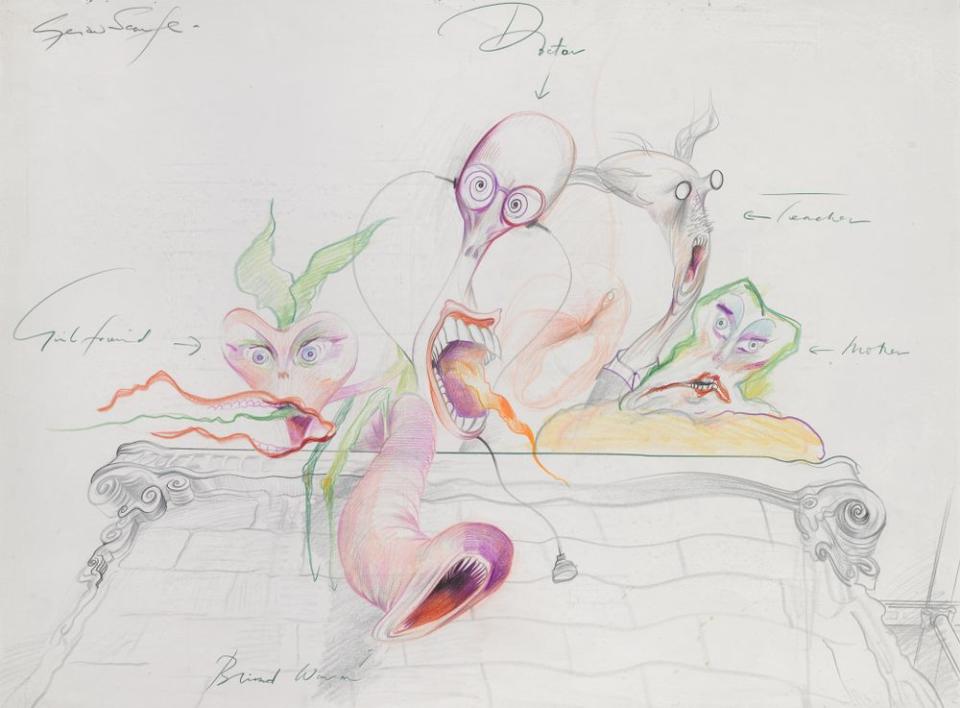
It was mainly Roger, I think, that I worked with at that time. He’s the one who is the most visually attuned. He’s the one who’s interested in images. And bit by bit, we worked towards what eventually became The Wall.
Was it designed from the beginning to be an album, a theatrical production and then a film, or did that evolve slowly from a smaller germ of an idea?
When Roger first came to my house in Chelsea in London, he brought the raw tapes that he’d sung himself into a synthesizer. He said, at that very point, “This is going to be an album, a show, and then a movie.” And, to his credit, he managed to pull off all three, which is pretty remarkable in the world of show business. So, yes, he had a very clear idea. When he brought these raw tapes to me, I didn’t have the musical imagination to see what it could become musically and what it has become, but I could immediately see images. Images are what I deal with. I could immediately see how these lyrics could be turned into remarkable pictures. And the great thing about adding pictures to music is it’s another dimension. It adds a bit more entertainment and imagination for the viewer.
I think when we first did the visual side, which was the stage production, it was quite hard for people to understand the concept of building a wall across the stage and alienating, cutting off, the band from their public. There were many people who said, “This is not going to work, because people paid to go and see the band and you’re going to put them behind a wall.” So they didn’t get it, they didn’t get the idea of it. Of course, that was where I came in. When the wall was up, I projected all my images onto it, and we had puppets and inflatables and all sorts of entertainment — the usual lights and fireworks and all that. But I think it was a difficult concept to sell originally as a theater piece.
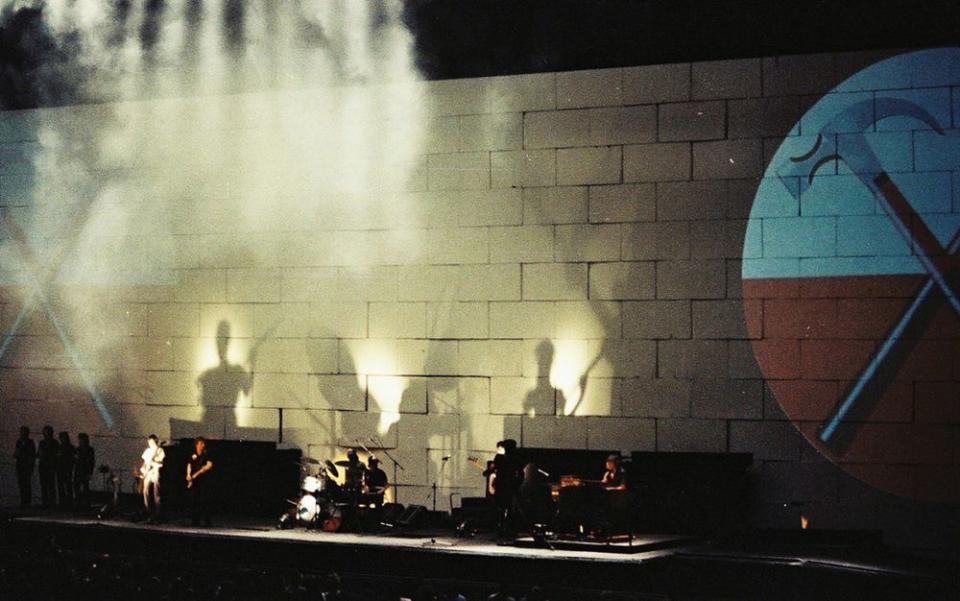
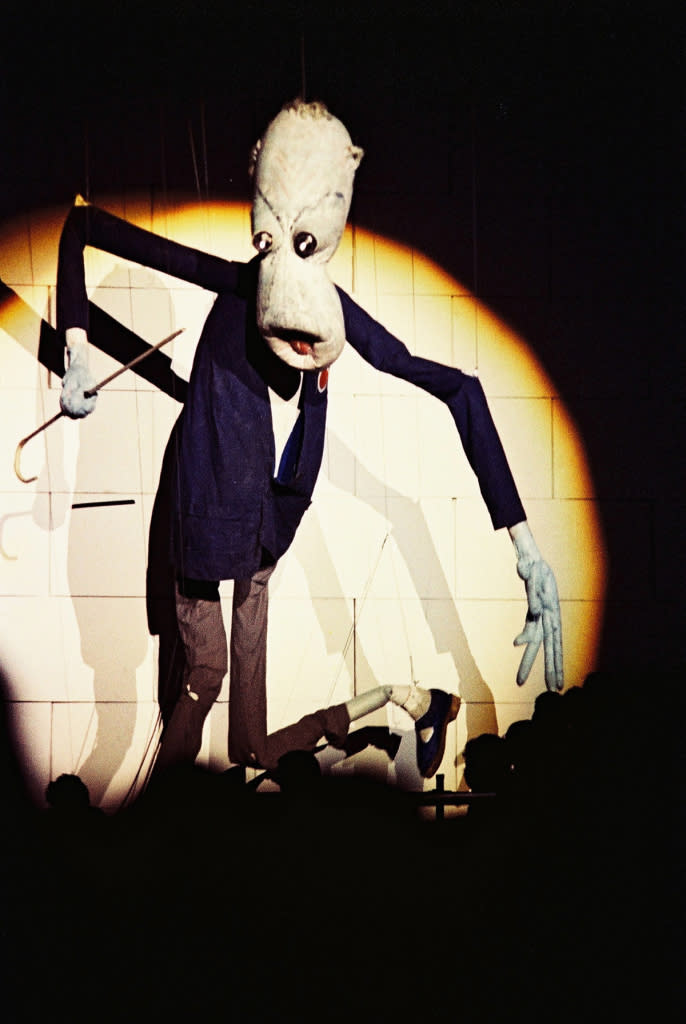
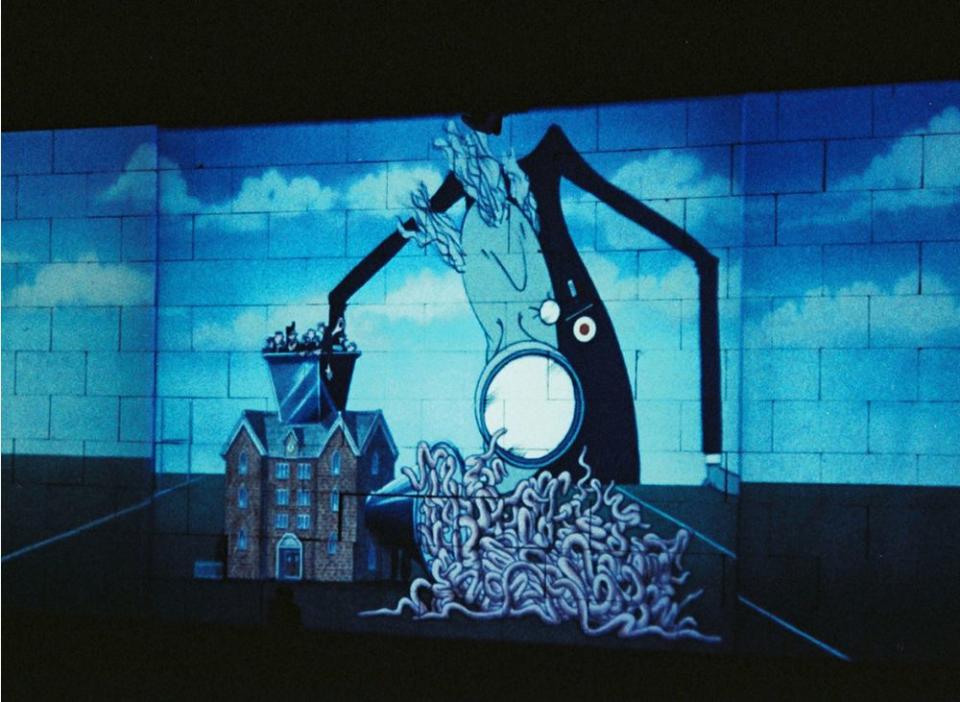
And the other thing Roger didn’t want at that point was at the end of show to play bits of old albums, which is the tradition. He wanted it to be a complete piece, with a start and a middle and end, and that was it. You’re not going to get any favorite old tunes at the end. All of that was quite difficult for producers to understand. But once again, he did it by force of personality. Roger, as you know, has a very strong personality, and he has to be listened to.
What was your working relationship like with Roger?
I mean, I liked him. He was a great friend of mine. We got on terribly well together, because he was sound and I was vision. We didn’t cross one another’s paths. The band was trouble, because like many bands do, they disagree about the music, and they say, “I’m the guy. I’m the main guy. You’re just riding on me,” and so forth. A lot of that goes on in bands all the time. They get the success of being the band and a corporate name, then they want to split off and be on their own. So there’s lots of trouble. But in my case, Roger and I, we went on holiday together, we went skiing, we played a lot of snooker. (Snooker is like the English pool.) We drank lots of very strong beer, Carlsberg Special Brew. All of that helped make the show — and the movie.
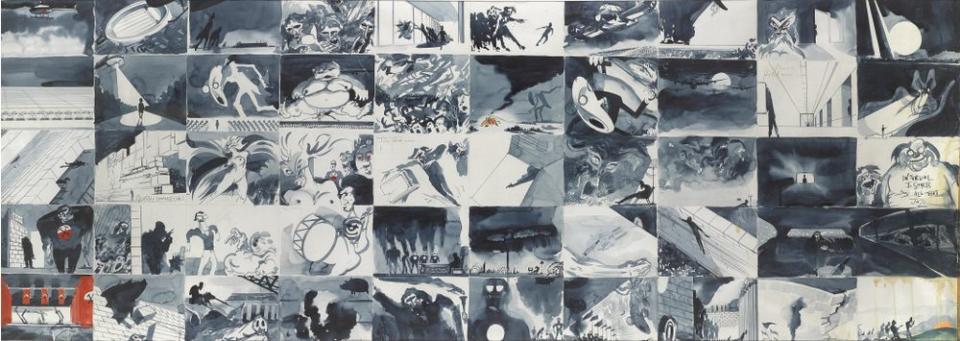
The plot mirrors Roger’s own father’s death during World War II. Did you get the impression early on that this was a deeply personal project for him? How much of his own feelings were discussed?
It was his magnum opus, or whatever you might call it. Yes, the tour before he described to me many times how he’d got absolutely pissed off with these audiences who didn’t listen. He told me the first four rows were going, “Wooooo!” They couldn’t hear a word. They were not listening to the music. They were just doing their own thing. He got so fed up with that, and he spat on this guy one night. Then he felt extremely ashamed about it. He talked to me about it several times and said that he was ashamed of what he’d done, but it was his reaction to people who just weren’t listening to what he was saying. And that became the wall, I suppose, between him and the audience. The other wall, he explained to me, is the wall that we all put up to protect our vulnerability. I mean, there are people in our lives who can affect us strongly. There are girlfriends, boyfriends. There are husbands, wives, even, in his case, a teacher at school who was sarcastic in front of the class, as teachers can be. That was a reason to put up a wall to protect your vulnerability, so that was one of the walls.
Of course, now, on his recent tour, he’s broadened that wall to talk about worldwide walls, Trump’s wall, and walls in the Middle East. The Berlin Wall fell, and there was a concert in Berlin when the wall came down. So walls have become his thing, but I think originally, yes, it was based on the Second World War, where his father was killed in Anzio. When he was a young boy, I think, he very much felt the loss of his father and talked about it a lot to me. It was a very touching moment in his life, naturally.
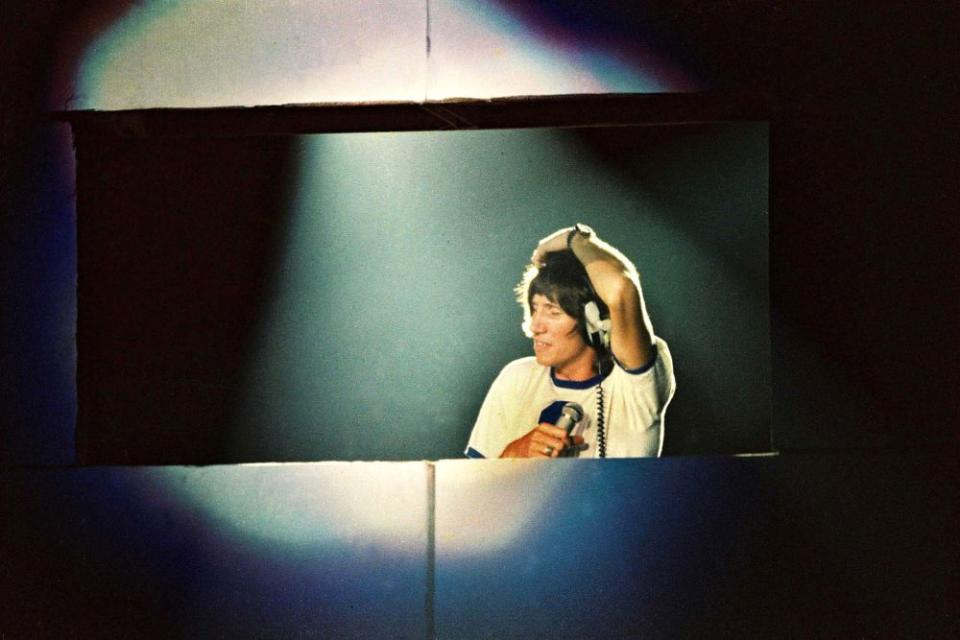
How much of your own experiences did you bring to the project?
Because I was born in 1936, it meant I saw England through the Second World War. We were in London, my parents and I, when Hitler was bombing London. We used to go down in the cellar beneath the house when the bombs were falling, and I can remember the sound of them now. There was bomb called a doodlebug, and it had a whistling sound, because it was driven by an engine. You could hear this engine droning overhead. When the engine cut out, as it was designed to do, you knew that the bomb was falling, and you never knew where it was going to fall. It could be on you.
But weirdly, because I was very young, I was mostly frightened of “the wolf.” I thought there was a wolf down in the cellar where I was, so I was mostly worried about the wolf and not about Hitler and his Luftwaffe. But yeah, I think that was the reason that Roger and I got on. He wasn’t born before the war, but he was born pretty soon after, so we had that in common.
And I used things from that experience. For instance, when I was down in the cellar, we had to wear gas-masks sometimes, for the fear of gas. And for young kids, they would make gas-masks with Mickey Mouse ears to try and fool the kids into believing that we’re having a good time — which, of course, you’re not. And for me, as an asthmatic, there’s nothing worse than a claustrophobic rubber mask over my face. You have a little plastic window to look out of it. It was horrific. But of course, when I came to do the Frightened Ones in the film, these troglodyte-like creatures that live underground, I gave them gas-mask heads, and that’s where that came from.
So yes, in that way, there are many things that came from my [experience]. It’s my imagination of what Roger meant, or what I knew. For instance, when he talked about the forces of oppression, those who were within the film, I immediately thought, “What is the most frightening, unthinking object I could think of?” And it was a hammer. I thought of a hammer, which is unyielding, and cruel and unthinking. And so, I came up with the hammers. And then I made the hammers march. And then, of course, Roger wrote, “Hammer, hammer, hammer” into the lyrics. So it did work the other way around a little bit. Not very often, but sometimes my images influenced the lyrics.
I noticed that teachers are an object of great scorn within the piece.
Because of my asthma, I missed most of my schooling, and therefore school and education was very, very difficult for me. I put a lot of my thoughts into the live-action education sequence in the movie, where I’ve got kids being pushed into the mincer to be processed into certain citizens in life.
In our country, we have very much a class system, and those who are in the poorer classes tend to get the worst education, and they are therefore prepared to stay within the world that they’re in at the moment — a poor world, with poor jobs. So yes, I have strong views on education, and my education was very, very poor. But I’ve been incredibly lucky. Because I can draw, I’ve managed to escape all of that. And people can escape through various things, like football, from poor backgrounds, or they can become rock stars from poor backgrounds. But in general, you are formed by the education that you have.

You’ve been quoted as saying that villains are the most interesting people to depict. What is it that makes them such compelling subjects for you?
My present villain — and my muse — is your President, but he’s always good material. I mean, all journalists know, it’s the baddies, the wicked ones, who make the best headlines, the best news. And if you go to a show, you’re not interested in the hero, or the heroine. You want the villain. You want the villain to come on. As we all know, even with Disney films, there’s always a villain, whether it’s Cruella de Vil, or in my case, Hades the God of the underworld. I was much more interested in designing Hades, the God of the underworld in my Hercules piece than anybody else, because he’s bad. He’s bad, and I thought because he lived in the underworld, that he would have an element of fire about him, so I always drew him with an element of flickering fire about him. When he was being sardonic or laid back, he has a flickering blue flame. But when he got angry, he would gust with fire. So I found a way with Hades of making fire itself be expressive, and express his mood.
Villains are my business. And of course, when I make drawings, political cartoons, it tends to be of the baddies in the world and the tyrants. A lot of my drawings are really about people who misuse power. They’re given power, or they fight for power and get their power, and then they misuse it usually to get their own way, or their own money, or whatever it happens to be.

On the flip side, I always felt that the flower scene in The Wall was some of the most beautiful work you’ve ever done — although I did find it interesting that the female devoured the male…
Yeah. Misogynist. [laughs]
What was the inspiration behind that sequence?
I think it actually started back in the days of Wish You Were Here. I just started drawing two flowers. Animation is a process sometimes of letting it happen to you. It dictates, I’ve discovered. If you introduce a figure into a frame of film, what are you going to do with him next? He could walk, he can tumble. He could do a somersault, he can jump. And after a while, if he does a somersault, you find he might want to do another one and he starts to dictate to you. I’ve heard authors say this about the books that they write. Once they’ve invented or designed their character, that character will tell them what he can and cannot do. He wouldn’t do this, or he would do that. It’s a fascinating thing.
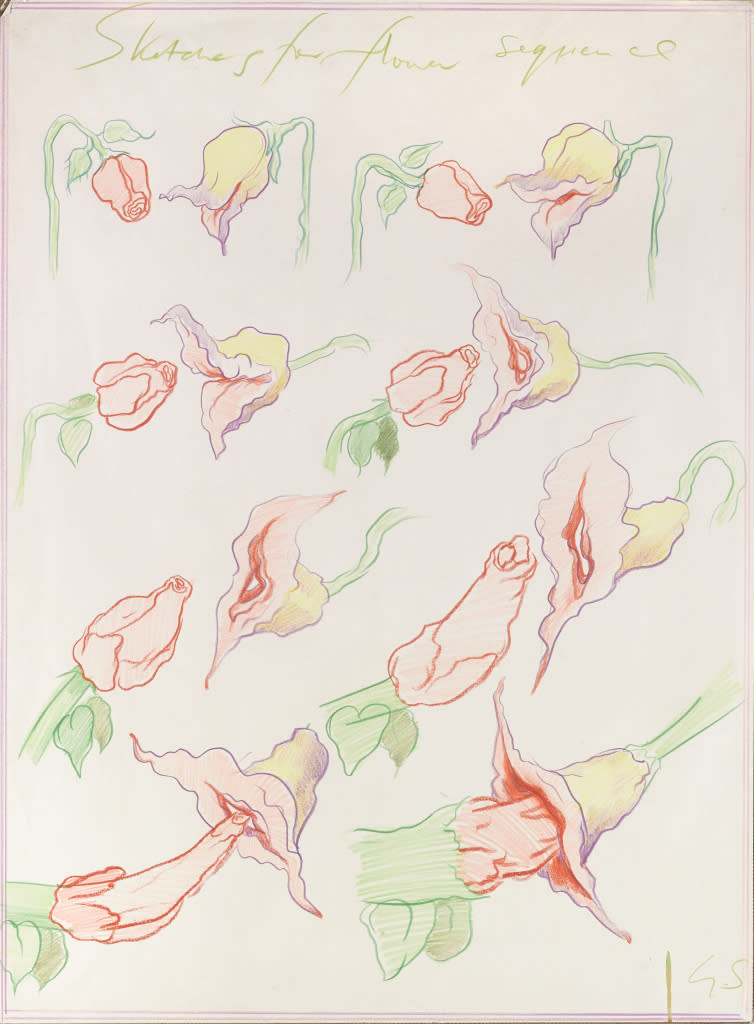
So I just drew these two flowers, and I really didn’t know when I first started what they would do. Slowly, they grew up and evolved, and they turned to exotic flowers. One, the female flower, is more exotic than the male — as is frequently the case. And then I came about with my misogynist move, where, as you say, the female devours the male and turns into a strange creature that flies away like a pterodactyl.
All of that took a long time to devise. And because it’s very, very slow, it requires a lot of drawings. And those drawings were done in colored pencil, and they would take up to two days per drawing. And each drawing, when it was finished, would be worthy of anybody’s wall to hang on. In fact, a lot of them were sold in a Christie’s sale some years ago. I have some myself, of course, in the collection that I’m selling.
They took forever to develop. In the meantime, I was working on other stuff as well, working on other bits of animation. But I had this team slowly drawing flowers. I guess that was shown at the Wish You Were Here tour and certainly early Wall shows.
But when we came to the movie, Alan Parker, who became the director, said, “It was the flowers that made me want to make this movie.” He just wanted to make a movie with flowers in it. And so, that’s what happened. And then it was decided, because of the piece of music it was going to accompany, “Empty Spaces,” that it needed to be longer. And then I added all the stuff during the filming of The Wall — the wall itself coming, thundering across the countryside. Everything it passed when it’s shadow fell on it turned to bad. Flowers, when the wall whistled by, would turn to barbed wire, and the child would turn into a monster. So in the shadow of the wall, everything turned bad.
And then it was really about a collection of desirables that some people want, like cars and guitars. It evolved over many, many years, with bits of animation that took years and years to put together.
At other end of spectrum, the cover for The Wall is very, very minimalist. How did that come together?
That had to be done very quickly, because the album was coming out. It’s like the video I made of “Another Brick in the Wall Part 2,” which had to be done in literally two days. But it was difficult with the album cover, because I had to invent all the characters there and then very, very quickly. Roger and the gang were down in France at the time, recording. I remember going down there and making sketches on Roger’s kitchen table of what these characters could look like. I didn’t want to make them too human looking, because they wouldn’t stay in the mind. I wanted some sort of strange-looking creatures that would stick in the mind and perhaps become iconic. And so, I went for these rather weird figures.
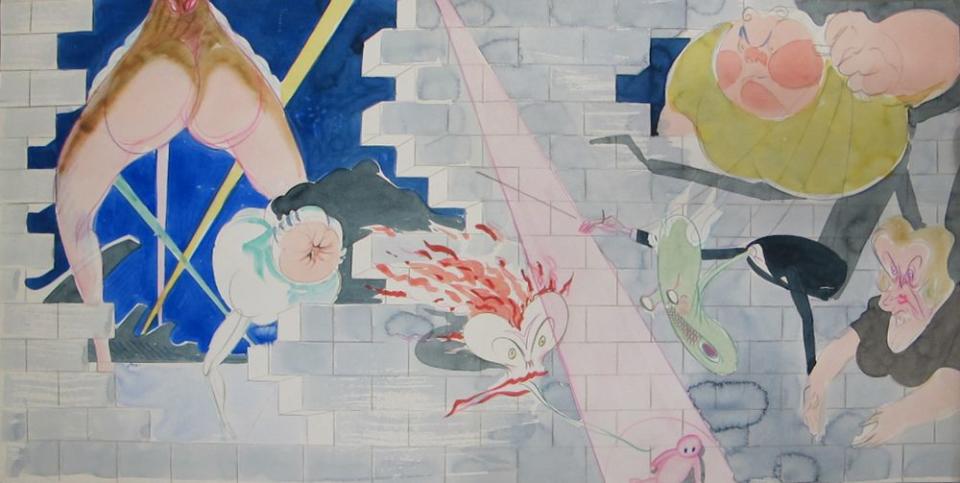
Roger himself thought The Wall cover should be just a wall, bricks with no illustration on it. Eventually, the producers wanted the name, “Pink Floyd’s The Wall,” put onto the blank bricks, but Roger didn’t want me to write it on the bricks. So I had to write it on a separate piece of cellophane, which in the original came separately and was just placed over the bricks, so that when you took the shrink-wrap off, it fell away, and you got a plain brick cover.
You mentioned earlier that you set out to make iconic images — and you certainly achieved it, which obviously doesn’t happen every day. Why do you feel these images for the album, and for the film, resonate with people so much?
To a certain extent, I guess, it’s repetition. [laughs] Like the Rolling Stones’ tongue. You see it so often, you just know immediately when you see it what it is and what it means, and what’s behind it. That’s repetition, I guess. It’s hard. I remember, when I came to do this Wall cover thinking, “Would it be realistic figures, or semi-cartoon figures, like The Simpsons?” Anyway, I pushed it to the ones you probably know, and I’m not sure how or why I got there. Well, I know why — because I had to come up with something different, something that would remain. But it is very hard, of course. If everybody could produce an iconic image every day of the week, they would be very rich.

Are there any fan tributes or compliments that you’ve received for your work on The Wall that were particularly meaningful to you?
Yes! There was a very nice guy who wrote to me asking if I could send him my signature. And I said, “What do you want it for?” And he said, “Well, I have all of your images, the screaming heads, and hammers and everything tattooed onto my arm and chest, and I’d just like the signature.” So I said, “Well, of course, it’s your body.” And, very kindly, he sent me a VHS or DVD of him having the tattoo done onto his arm with my signature. And in the meantime, while he was having it done, the tattooist is mopping away the blood trickling down the arm, he said, “Mr. Scarfe, I want to thank you for what you did for me in the Gulf War. Your images and the music of Pink Floyd got me through.” I thought, “This is incredible.” But he really meant it, because at the end, he said, “In token for what you’ve done for me, I’m going to send you my Gulf War medal.” Which he did. He sent me his Gulf War medal! Now, naturally, I sent it back, and I said, “You’re the hero. I’m just an artist. I don’t do what you did.” But that’s extraordinary. That just shows what power music and images can have for people, so I will always remember that. I’ve got a photograph of him. Eventually, Roger signed his arm too, but I think that with a Sharpie not with a tattoo needle.
Music and images are very evocative. You can remember songs when you met your girlfriend or your boyfriend — Frank Sinatra, Ella Fitzgerald, or whatever your era happens to be. There are certain of pieces of music that bring the whole of that back for you.

